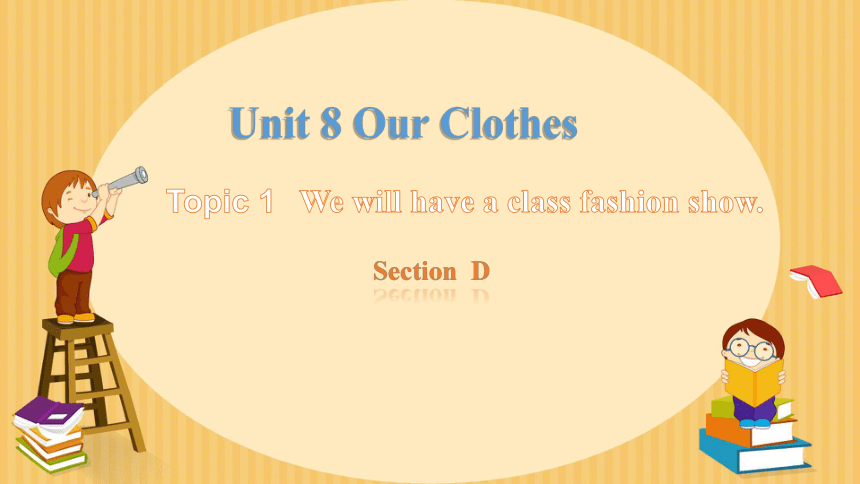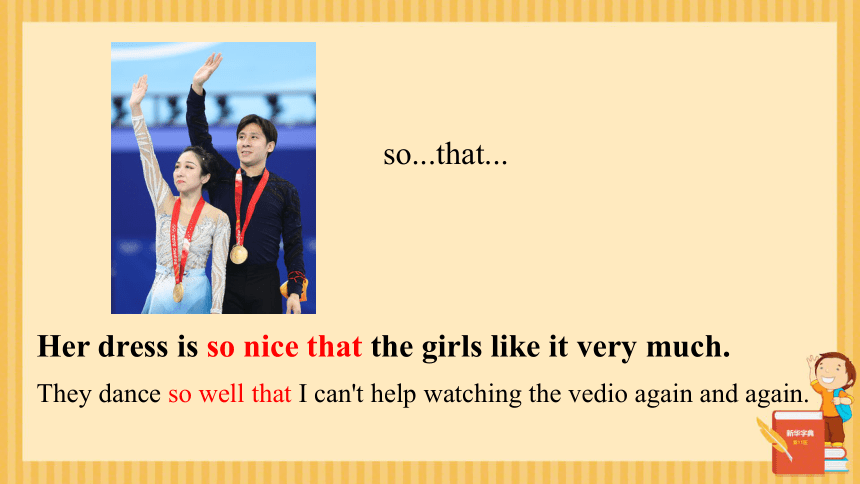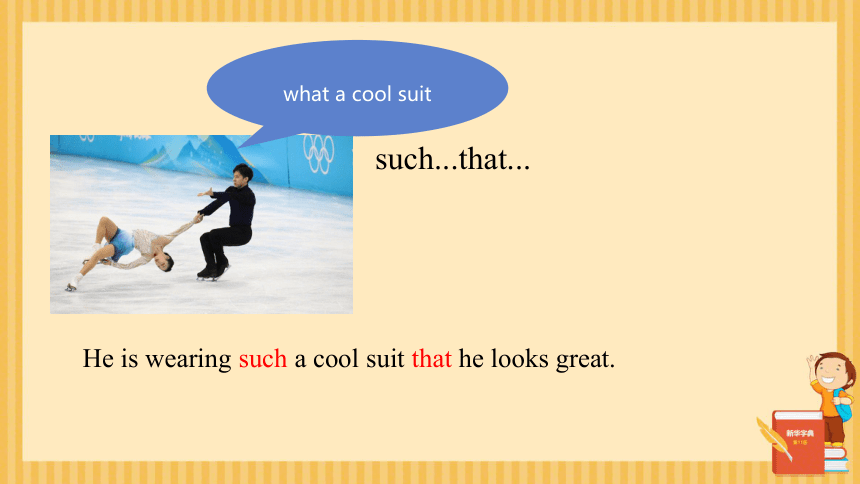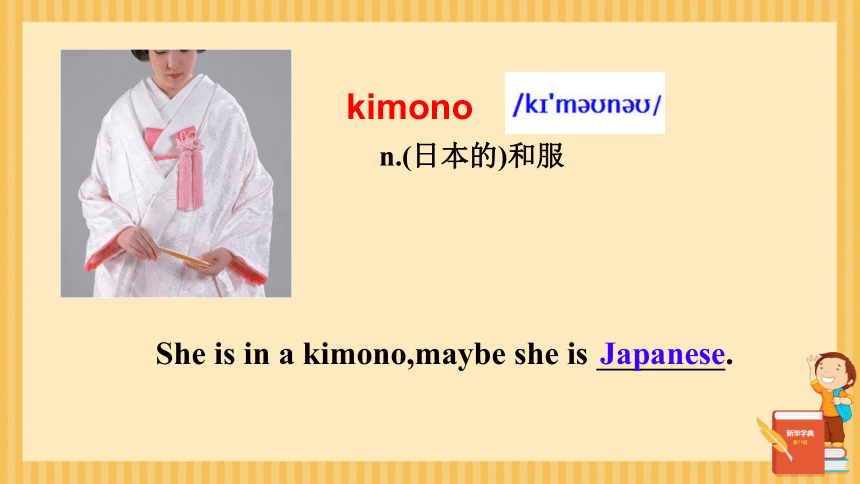Unit 8 Our Clothes Topic 1 We will have a class fashion show Section D 课件(共22张PPT,内嵌视频)
文档属性
| 名称 | Unit 8 Our Clothes Topic 1 We will have a class fashion show Section D 课件(共22张PPT,内嵌视频) |

|
|
| 格式 | pptx | ||
| 文件大小 | 28.5MB | ||
| 资源类型 | 教案 | ||
| 版本资源 | 仁爱科普版 | ||
| 科目 | 英语 | ||
| 更新时间 | 2025-04-25 10:59:04 | ||
图片预览









文档简介
(共22张PPT)
Unit 8 Our Clothes
Topic 1
Section D
We will have a class fashion show.
Teaching objectives:
1.Review the sentence with so/such...that...
2.Be able to talk about the fuctions of clothes in English.
3.Master the skills for comprehension.
Enjoy a vedio
Her dress is so nice that the girls like it very much.
so...that...
They dance so well that I can't help watching the vedio again and again.
such...that...
He is wearing such a cool suit that he looks great.
what a cool suit
kimono
n.(日本的)和服
She is in a kimono,maybe she is .
Japanese
Chinese culture
Look at the pictures and guess about the people based on what they wear. Then read and check your ideas.
uniform
kimono
sportswear
easy-going
[ ju n f m]
[k m n ]
[ sp tswe (r)]
Task1 Skimming
Read 1a and find out the topic sentence
Clothing can also show people our jobs, our culture, our hobbies and even our moods.
The first types of clothes were made of animal skins. People started to wear clothes so that they could protect themselves from the sun, wind, rain and cold.
Today, we use different materials to make different kinds of clothes. But nowadays, clothes do more than just keep us warm. Clothing can also show people our jobs, our culture, our hobbies and even our moods. For example, when we see a man in a uniform, we can guess his job from the uniform. When we see a woman in a kimono, we may think that she is Japanese. If a man always wears sportswear, we may think he is active and likes doing exercise. If a person always wears yellow or pink clothes, maybe he or she is lively and easy-going. We get ideas about people from their clothes. As the saying goes, “You are what you wear.”
( )1.Why did people start to wear clothes
A.to look nice B.to protect themselves
C.to show fashion D.to find them easily
( )2.When you see a man in a uniform, what can you guess
A.his job B. his culture C. his hobby D. his mood
( )3.If a man is active, which kind of clothes may he like
A.sweater B. sportswear C. uniforms D. kimono
B
B
A
Task2 Reading comprehensions
( )4.Which of the following is true
A.People wore the first types of clothes to show fashion.
B.Nowadays, clothes not only keep us warm.
C.Clothes can tell what your names are.
D.People almost wear the same kind of clothes now.
( )5.What does the passage mainly talk about
A.The history of clothes. B. The functions of clothes.
C.The styles of clothes. D. The types of clothes.
B
B
function
n. 功能, 作用 ['f k n]
Task3 Key points
1. 由...制成(看得出原材料)
2. 由...制成(看不出原材料)
3.开始做某事
4.为了;以便于...
5.保护某人免受...的伤害
6.使用某物做某事
7.不同种类的
8.超过
9.保持某人/某物处于...状态
10.给某人看某物
11.例如
12.从某人那里得到某物
13.正如习语所说
14.衣如其人
1. be made of
2. be made from
3.start/begin to do sth
4. so that +从句
5.protect sb from sth/doing sth
6.use sth to do sth
7.different kinds of
8. more than=over
9.keep sb/sth + adj.
10.show sb sth = show sth to sb
11 for example
12.get sth from sb
13.as the saying goes
14.You are what you wear.
Task4 Fill in the blanks
People started _______ so that _____ could protect________
from_________________.
But nowadays, clothes do___________just keep________________.
Clothing can also show people our______________________________
and even _______. For example, ________________in a uniform,
we can ____________from the uniform. When__________in a kimono,
we may think _______________. If ________________sportswear,
we may think _______________________. If ________________yellow
or pink clothes, maybe ________________________.
We get ideas about people from___________.
As the saying goes, “________________.”
Task5 Deep thinking
What’s the meaning of the sentence
“You are what you wear.”
You can judge a person from his clothes.
Task6 Creative thinking
When you see the clothes, what do you think of it
Enjoy a vedio
Don't always judge a man by his clothes.
practice
用so…that…和such…that…填空
1.It is a heavy stone I can’t carry it.
2.The book is interesting I want to read it again.
3.It was a fine day we couldn’t wait to go out.
4.Jack is clever he can work out this difficult problem.
5.My sister ran fast I couldn’t catch up with her.
6.He has few friends he often feels lonely.
such
so
so
so
such
so
that
that
that
that
that
that
practice
Write a passage, describe a person from his clothes.
He/she is wearing a ...
Thanks
Unit 8 Our Clothes
Topic 1
Section D
We will have a class fashion show.
Teaching objectives:
1.Review the sentence with so/such...that...
2.Be able to talk about the fuctions of clothes in English.
3.Master the skills for comprehension.
Enjoy a vedio
Her dress is so nice that the girls like it very much.
so...that...
They dance so well that I can't help watching the vedio again and again.
such...that...
He is wearing such a cool suit that he looks great.
what a cool suit
kimono
n.(日本的)和服
She is in a kimono,maybe she is .
Japanese
Chinese culture
Look at the pictures and guess about the people based on what they wear. Then read and check your ideas.
uniform
kimono
sportswear
easy-going
[ ju n f m]
[k m n ]
[ sp tswe (r)]
Task1 Skimming
Read 1a and find out the topic sentence
Clothing can also show people our jobs, our culture, our hobbies and even our moods.
The first types of clothes were made of animal skins. People started to wear clothes so that they could protect themselves from the sun, wind, rain and cold.
Today, we use different materials to make different kinds of clothes. But nowadays, clothes do more than just keep us warm. Clothing can also show people our jobs, our culture, our hobbies and even our moods. For example, when we see a man in a uniform, we can guess his job from the uniform. When we see a woman in a kimono, we may think that she is Japanese. If a man always wears sportswear, we may think he is active and likes doing exercise. If a person always wears yellow or pink clothes, maybe he or she is lively and easy-going. We get ideas about people from their clothes. As the saying goes, “You are what you wear.”
( )1.Why did people start to wear clothes
A.to look nice B.to protect themselves
C.to show fashion D.to find them easily
( )2.When you see a man in a uniform, what can you guess
A.his job B. his culture C. his hobby D. his mood
( )3.If a man is active, which kind of clothes may he like
A.sweater B. sportswear C. uniforms D. kimono
B
B
A
Task2 Reading comprehensions
( )4.Which of the following is true
A.People wore the first types of clothes to show fashion.
B.Nowadays, clothes not only keep us warm.
C.Clothes can tell what your names are.
D.People almost wear the same kind of clothes now.
( )5.What does the passage mainly talk about
A.The history of clothes. B. The functions of clothes.
C.The styles of clothes. D. The types of clothes.
B
B
function
n. 功能, 作用 ['f k n]
Task3 Key points
1. 由...制成(看得出原材料)
2. 由...制成(看不出原材料)
3.开始做某事
4.为了;以便于...
5.保护某人免受...的伤害
6.使用某物做某事
7.不同种类的
8.超过
9.保持某人/某物处于...状态
10.给某人看某物
11.例如
12.从某人那里得到某物
13.正如习语所说
14.衣如其人
1. be made of
2. be made from
3.start/begin to do sth
4. so that +从句
5.protect sb from sth/doing sth
6.use sth to do sth
7.different kinds of
8. more than=over
9.keep sb/sth + adj.
10.show sb sth = show sth to sb
11 for example
12.get sth from sb
13.as the saying goes
14.You are what you wear.
Task4 Fill in the blanks
People started _______ so that _____ could protect________
from_________________.
But nowadays, clothes do___________just keep________________.
Clothing can also show people our______________________________
and even _______. For example, ________________in a uniform,
we can ____________from the uniform. When__________in a kimono,
we may think _______________. If ________________sportswear,
we may think _______________________. If ________________yellow
or pink clothes, maybe ________________________.
We get ideas about people from___________.
As the saying goes, “________________.”
Task5 Deep thinking
What’s the meaning of the sentence
“You are what you wear.”
You can judge a person from his clothes.
Task6 Creative thinking
When you see the clothes, what do you think of it
Enjoy a vedio
Don't always judge a man by his clothes.
practice
用so…that…和such…that…填空
1.It is a heavy stone I can’t carry it.
2.The book is interesting I want to read it again.
3.It was a fine day we couldn’t wait to go out.
4.Jack is clever he can work out this difficult problem.
5.My sister ran fast I couldn’t catch up with her.
6.He has few friends he often feels lonely.
such
so
so
so
such
so
that
that
that
that
that
that
practice
Write a passage, describe a person from his clothes.
He/she is wearing a ...
Thanks
同课章节目录
- Unit 5 Feeling excited
- Topic 1 You look excited
- Topic 2 I’m feeling better now.
- Topic 3 Many things can affect our feelings.
- Unit 6 Enjoying Cycling
- Topic 1 We're going on a three-day visit to Mount
- Topic 2 How about exploring Tian’anmen Square?
- Topic 3 Bicycle riding is good exercise.
- Unit 7 Food festival
- Topic 1 We’re preparing for a food festival.
- Topic 2 I’m not sure whether I can cook it well.
- Topic 3 I Cooked the Most Successfully
- Unit 8 Our Clothes
- Topic 1 We will have a class fashion show.
- Topic 2 We can design our own uniforms.
- Topic 3 He said the fashion show was wonderful.
